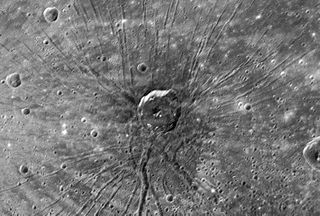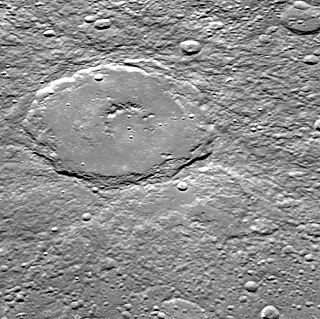
A sextant is a doubly reflecting navigation instrument that measures the angular distance between two visible objects. The primary use of a sextant is to measure the angle between an astronomical object and the horizon for the purposes of celestial navigation.

A terminator or twilight zone is a moving line that divides the daylit side and the dark night side of a planetary body. The terminator is defined as the locus of points on a planet or moon where the line through the center of its parent star is tangent. An observer on the terminator of such an orbiting body with an atmosphere would experience twilight due to light scattering by particles in the gaseous layer.

The four cardinal directions, or cardinal points, are the four main compass directions: north, south, east, and west, commonly denoted by their initials N, S, E, and W respectively. Relative to north, the directions east, south, and west are at 90 degree intervals in the clockwise direction.

Faustini is a lunar impact crater that lies near the south pole of the Moon. It is located nearly due south of the much larger crater Amundsen, and is almost attached to Shoemaker to the southwest. About one crater diameter due south is the smaller crater Shackleton at the south pole. A small crater is attached to the eastern rim of Faustini.

The white-letter hairstreak is a butterfly in the family Lycaenidae.

A rainbow is an optical phenomenon caused by refraction, internal reflection and dispersion of light in water droplets resulting in a continuous spectrum of light appearing in the sky. The rainbow takes the form of a multicoloured circular arc. Rainbows caused by sunlight always appear in the section of sky directly opposite the Sun. Rainbows can be caused by many forms of airborne water. These include not only rain, but also mist, spray, and airborne dew.

Satyrium acaciae, the sloe hairstreak, is a butterfly in the family Lycaenidae.

Yeats is an impact crater on the planet Mercury. The crater is named after William Butler Yeats, an Irish poet and dramatist. The name was adopted by the International Astronomical Union in 1976.

Sun path, sometimes also called day arc, refers to the daily and seasonal arc-like path that the Sun appears to follow across the sky as the Earth rotates and orbits the Sun. The Sun's path affects the length of daytime experienced and amount of daylight received along a certain latitude during a given season.

Matisse is an impact crater on the southern hemisphere of Mercury. Matisse takes its name from the French artist Henri Matisse, and it was named by the IAU in 1976.

Mozart is a crater on Mercury, named by the IAU in 1976 after Austrian composer Wolfgang Amadeus Mozart.

Apollodorus is an impact crater on Mercury. Its unusual appearance, with radiating dark troughs, led to a nickname of "the Spider" by scientists before its official name was decided. Apollodorus is located near the center of Pantheon Fossae, which is a system of radial grabens situated in the inner part of the Caloris basin. The floor, rim and walls of Apollodorus expose a low reflectance material (LRM) excavated during the impact from beneath the light volcanic plains, which cover the central part of the Caloris.

Xiao Zhao crater is small in comparison with many other craters on Mercury. However, Xiao Zhao's long bright rays make it a readily visible feature. The fresh, bright rays, which were created by material ejected outward during the impact event that formed the crater, indicate that Xiao Zhao is a relatively young crater on Mercury's surface.

Stravinsky is a crater on Mercury. It overlays the rim of the much older Vyāsa crater. It was named by the IAU in 1979 for the influential Russian composer Igor Stravinsky.
Skyline Solar was a Concentrated Photovoltaic (CPV) company based in Mountain View, California. The company developed medium-concentration photovoltaic systems to produce electricity for commercial, industrial and utility scale solar markets. The company was founded in 2007 by Bob MacDonald, Bill Keating and Eric Johnson. The operation of the company appears to have ceased in late 2012 and the website is deactivated.

Amaral is a crater on the planet Mercury. With its smooth floor, surrounding ejecta, and small secondary craters, it appears noticeably younger than the heavily cratered surface around it. Along with a smooth crater floor, Amaral also has a central peak. Bright material on this peak is of particular interest as it appears to have an unusual color. In color-enhanced images, the central peak of Amaral appears as a bright blue color in striking contrast to the otherwise orange tones of surface material nearby. The different color of the central peak likely indicates rocks with different chemical composition from those on the neighboring surface.

Bartók is a crater on Mercury. Its name was adopted by the International Astronomical Union (IAU) in 1979. Bartók is named for the Hungarian composer Béla Bartók, who lived from 1881 to 1945.

Darío is a crater on Mercury. It has a diameter of 151 kilometers. Its name was adopted by the International Astronomical Union (IAU) in 1976. Dario is named for the Nicaraguan poet Rubén Darío, who lived from 1867 to 1916.

Liang Kʻai is a crater on Mercury. It has a diameter of 140 kilometers. Its name was adopted by the International Astronomical Union in 1979. Liang Kʻai is named for the Chinese artist Liang Kai, who lived from 1140 to 1210.
Caylin Hauptmann is a former American football offensive lineman. He signed with the Cleveland Browns as an undrafted free agent in 2013. He was signed to the Seattle Seahawks in September 2013.





















